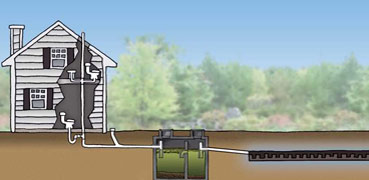
To plan your ideal home and watch it come into being is a pretty amazing process. And there’s probably nothing like the topic of sewage to burst that happy bubble where you daydream about your new home.
Buzzkill or not, building a house in rural New England often means a private septic system might form a crucial part of your new home reality. You won’t just be making decisions about laminate vs. hardwood flooring or what color the exterior of your house should be. You’re going to have to deal with something that sounds nasty even to just say it aloud: effluence.
Let’s make sure we even know what a septic system is. The main objective of a septic system is to remove waste from the house, disperse effluence into the ground, and then let nature take over the job of “treating” the water. That is, filtering the liquid waste through soil, sand, and gravel and returning it into the aquifer from which it originated.
Very early on in the construction of your home, a general contractor will talk to you about what kind of septic system your property will need. The best system will depend on a combination of factors, such as how many people live in the house and the soil composition and soil depth of your land.
In most cases, though, your septic choice will be among a set of four standard options.
Gravity Fed: In this passive system, waste leaves the house through a pipe, which is connected to a fiberglass or concrete tank. Inside the tank, naturally occurring bacteria break down the solids contained in the incoming waste. Eventually, as more sewage comes into the tank, gravity forces the old sewage out. It is dispersed through a series of perforated pipes that are buried in gravel-filled trenches several feet under the ground.
Pressure Distribution: This system is similar to the gravity fed system, except that it includes a pump. Instead of waste gradually ending up in the drain field (or leach field), the pump periodically floods the drain field with effluence.
Sand Filter: This system also uses pumps, but instead of the waste being pumped directly into the soil, it is first dispersed through a series of pressurized lines placed atop a bed of gravel. From there, the effluence trickles down through what is, essentially, a box of sand. The sand treats the wastewater, which collects in a drain under gravel and is then moved into a second pump chamber before being pumped into a drain field.
Mound: In this system, pumps disperse effluence into a sand- and gravel-filled bed that is constructed above the natural surface of the ground.
It’s details like this that can make the difference between a house that’s easy to maintain and one that requires far more attention far more frequently. For more information on other important aspects of building a house, check out our blog on construction terms you need to know!
For more information, contact Morse Engineering and Construction.

